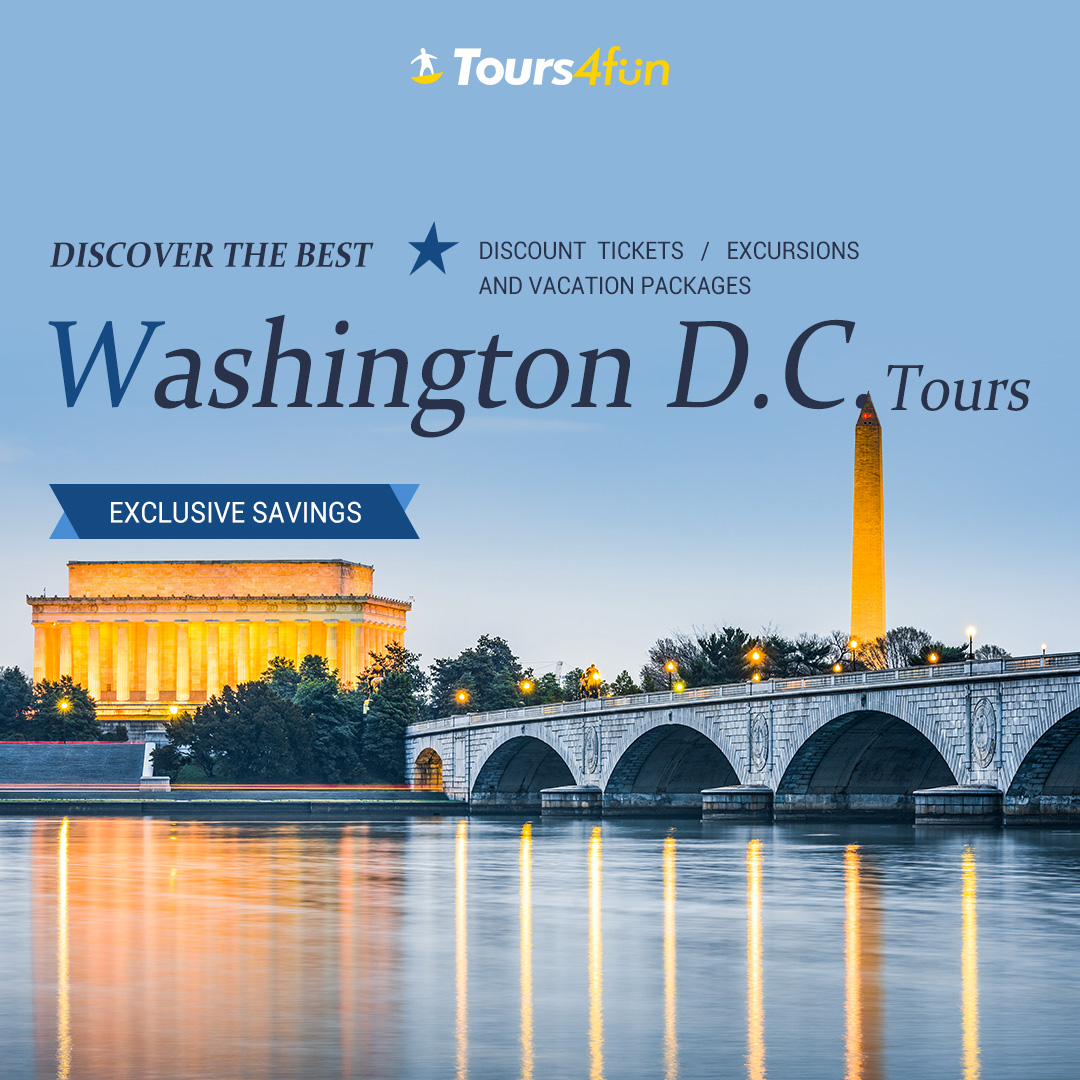
Washington DC White House Tour
The White House is one of the most iconic buildings in the world, and a visit to Washington DC is not complete without going to see it! The tour is free and open to the public so I recommend you check it out.
How to Schedule a Tour
The first thing you should do before visiting the White House is to request a tour. This is best done through your congressional representative. You can find their contact info based on your zip code at this website:
Make sure you know what time the tours are available, as they fill up quickly on a first-come, first-serve basis. You’ll want to submit your request a minimum of 21 days in advance, and no more than 90 days in advance.
After submitting your request, you’ll receive an email with more details and an invoice for the cost of your tour. You can also sign up for email alerts when the tour is available.
You’ll need to arrive at least 15 minutes before the start of your tour and you should be ready to get your name on the list and have your identification checked. This is all outdoors, so you’ll need to be prepared for some extra walking time!
What to Bring
To make sure you don’t have anything confiscated by security, don’t take any backpacks or bags into the White House. This is because they don’t have lockers to store items and you’ll need to leave them at your hotel if you want to avoid having to carry it around during the tour.
There’s a lot of information about what is allowed and not on the White House website so read it carefully. This includes photos and videos, so be sure to only bring those that don’t interfere with other visitors or guards.
What you should NOT bring
The biggest rule is that you can’t bring any type of video camera into the White House. This is because cameras can be used to capture the President’s personal details and that may be a violation of his privacy.
If you’re worried about bringing your camera in, you can leave it at your hotel, or take it to the visitor’s center before you arrive. The visitor’s center is also a good place to check out exhibits and watch a short video of the White House before you get inside.
What to Expect on the Tour
A White House tour is self-guided and consists of a set mapped route that takes you from the East Wing to the State Floor. The route features the Visitors Foyer, the East Colonnade, the Family Movie Theater, the Library, China Room, Vermeil Room, East Garden, Green Room, Blue Room, Red Room and State Dining Room.
During the tour, you’ll see some presidential portraits and a few other historical items in the rooms. This is a great way to learn about the history of the White House and how it is used today.
The Smithsonian Museums in Washington DC
The Smithsonian Museums are an integral part of Washington DC, and a great way to spend your day. From Asian art to Native American history, these museums provide a glimpse into the past and the future of our nation.
Some of the most popular Smithsonian museums include the Museum of Natural History, National Air and Space Museum and the National Portrait Gallery. The museum is also home to the famous Henry, a 14-foot, 12-ton elephant.
1. Museum of Natural History
The National Museum of Natural History is the largest Smithsonian Institution museum in the world and houses an extraordinary collection of natural specimens. This world-renowned museum is a popular attraction for visitors to Washington, DC and is free to visit.
The Museum of Natural History is situated on the National Mall and is open daily from 10 am to 5:30 pm. It is best accessed by Metrorail or the DC Circulator’s National Mall bus.
The Museum of Natural History is a great place for families with young children and older adults to learn about the world’s natural history. It has a number of exhibits that cover dinosaurs, ocean life, the Hope Diamond, geology and more.
2. National Museum of African American History and Culture
The National Museum of African American History and Culture, a relatively new addition to the historic National Mall, is a state-of-the-art building dedicated to the African American experience. From the arts to sports and the Civil Rights Movement, this building celebrates African American contributions to history and culture.
The exterior of the building, conceived by Ghanaian-born architect David Adjaye, blends design elements from African and American cultures. It features a three-tiered lattice work that pays tribute to the intricate ironwork of slaves in the American South.
The museum offers a number of different programs for visitors of all ages. For instance, the Explore Your Family History Center allows visitors to delve into digital resources related to family history and receive expert guidance on how to conduct genealogical research and oral history interviews.
3. National Museum of American History
One of the largest Smithsonian Museums in the world, the National Museum of American History in Washington DC is a place to see nearly every facet of American history. From the mechanical devices that power America’s industrial revolution to pop culture, transportation, food, and presidential history, there is something for everyone at this historic institution!
The flag that flew over Baltimore’s Fort McHenry during the War of 1812 inspired Francis Scott Key to write the Star Spangled Banner. This massive flag is the centerpiece of the National Museum of American History.
In addition to the flag, there are a number of other important artifacts on display, including the top hat worn by President Abraham Lincoln during his assassination in 1865. The museum also has an incredible collection of First Ladies’ gowns and accessories that reflect their role in American history.
4. National Portrait Gallery
A branch of the Smithsonian Institution, the National Portrait Gallery houses portraits of the great American figures who helped shape our country. It’s a must-visit destination for history buffs.
The museum is housed in the Old Patent Office Building, a Greek Revival-style building constructed in 1836. It once served as a military hospital and was the site of President Lincoln’s second inaugural ball.
The National Portrait Gallery features a collection of over 20,000 paintings, sculptures, drawings and photographs. It narrates the stories of American life, capturing the aspirations, character and imagination of the people who shaped our nation’s culture.
5. National Air and Space Museum
The National Air and Space Museum is the largest aviation and space artifact collection in the world. Its three galleries display historic flying machines, including the Wright Flyer and Apollo command modules.
The museum also features a planetarium and an IMAX theater that offers shows throughout the day. It is a popular tourist destination in Washington, DC and attracts more than seven million visitors each year.
This museum is located on the National Mall in Washington, DC and is part of the Smithsonian Institution. It is undergoing a seven-year renovation that began in 2018 and involves the redesign of all 23 exhibition spaces.

Washington DC’s Jefferson Memorial
Dedicated to Thomas Jefferson, one of the Founding Fathers and third president of the United States, the Jefferson Memorial is a classically elegant structure that sits over the ebb and flow of the Potomac River. It was commissioned in 1934 by Franklin Roosevelt, an admirer of Jefferson who wanted to honor his greatness.
Designed by John Russell Pope, this building was inspired by the Pantheon in Rome and was completed in 1943. Its half-circular open rotunda, enclosed dome and open portico mimic the classical style that Jefferson greatly admired. Its bronze statue of Jefferson, sculpted by Rudulph Evans, looks stoically towards the White House.
The exterior of the Jefferson Memorial is made of Vermont Danby Imperial marble and the interior walls are covered in pink and gray Tennessee marble. The circular memorial hall is surrounded by 16 columns and a nearly 6-meter-high bronze statue of Jefferson stands in the center.
Inscriptions on the inside of the domed memorial are a reminder of all that Jefferson accomplished and how his work led to the American Revolution and democracy. On the southwest wall, a famous quote from the Declaration of Independence is engraved. On the northwest wall, a few inscriptions from religious documents, such as Jefferson’s Statue of Virginia for Religious Freedom, are also displayed.
You can’t get much closer to the man who wrote the Declaration of Independence than at this gracefully domed, white marble memorial. Here you’ll find a stately bronze statue of Jefferson, his most memorable quotes engraved on the interior walls and his original drafts of the Declaration hanging on the back wall.
The Jefferson Memorial is open 24 hours a day and is free to enter. It can be reached on foot or by public transport using the Metro (orange, blue and silver lines), buses 32, 34 or 36 or the DC Circular Bus.
While there, you can also see the beautiful Japanese flowering cherry trees that are in bloom around the memorial. It is the perfect spot to enjoy a peak bloom at the start of the season, especially at the beginning of the summer.
Located in West Potomac Park on the south shore of the Tidal Basin, the Jefferson Memorial is one of the main points on the National Mall that forms a symbiotic relationship with the Washington Monument and the White House. It was commissioned in 1934 and built from 1939 to 1943, under the direction of President Franklin Roosevelt.
There’s a lot to love about the Jefferson Memorial, but my favorite is the beautiful view of the White House from the steps leading up to the memorial. This is a fantastic place to go to watch the sunset and take in the beautiful views of the city.
The Jefferson Memorial is a beautiful classical revival structure and was designed by renowned architect John Russell Pope, who had also completed two major revival works in the District of Columbia. He originally designed the Jefferson Memorial to look like a part of the Roman Parthenon, but his design was revised after Pope’s death in 1937. He was replaced by architects Otto R. Eggers and David P. Higgins, who worked in conjunction with Pope to rework the design. The final version is the one we have today.
